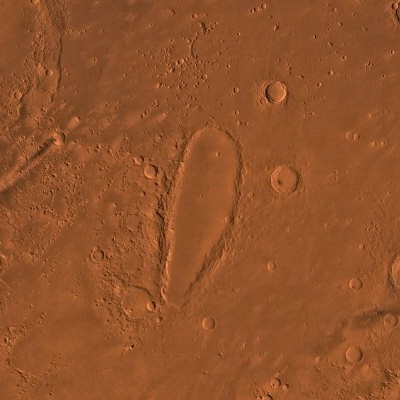
Olympus Mons is an enormous shield volcano on the planet Mars. The volcano has a height of over 21.9 km as measured by the Mars Orbiter Laser Altimeter (MOLA). Olympus Mons is about two and a half times Mount Everest's height above sea level. It is the largest and highest mountain and volcano of the Solar System, and is associated to the Tharsis Montes, a large volcanic region on Mars.

Syrtis Major Planum is a "dark spot" located in the boundary between the northern lowlands and southern highlands of Mars just west of the impact basin Isidis in the Syrtis Major quadrangle. It was discovered, on the basis of data from Mars Global Surveyor, to be a low-relief shield volcano, but was formerly believed to be a plain, and was then known as Syrtis Major Planitia. The dark color comes from the basaltic volcanic rock of the region and the relative lack of dust.
In planetary nomenclature, a fossa is a long, narrow depression (trough) on the surface of an extraterrestrial body, such as a planet or moon. The term, which means "ditch" or "trench" in Latin, is not a geological term as such but a descriptor term used by the United States Geological Survey (USGS) and the International Astronomical Union (IAU) for topographic features whose geology or geomorphology is uncertain due to lack of data or knowledge of the exact processes that formed them. Fossae are believed to be the result of a number of geological processes, such as faulting or subsidence. Many fossae on Mars are probably graben.

Alba Mons is a volcano located in the northern Tharsis region of the planet Mars. It is the biggest volcano on Mars in terms of surface area, with volcanic flow fields that extend for at least 1,350 km (840 mi) from its summit. Although the volcano has a span comparable to that of the United States, it reaches an elevation of only 6.8 km (22,000 ft) at its highest point. This is about one-third the height of Olympus Mons, the tallest volcano on the planet. The flanks of Alba Mons have very gentle slopes. The average slope along the volcano's northern flank is 0.5°, which is over five times lower than the slopes on the other large Tharsis volcanoes. In broad profile, Alba Mons resembles a vast but barely raised welt on the planet's surface. It is a unique volcanic structure with no counterpart on Earth or elsewhere on Mars.

Cleopatra, initially called Cleopatra Patera, is an impact crater on Venus, in Maxwell Montes.
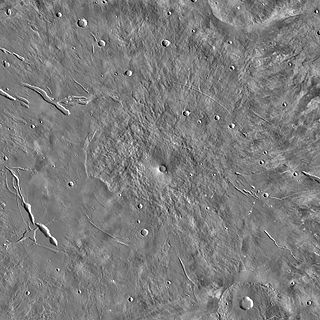
Elysium Mons is a volcano on Mars located in the volcanic province Elysium, at 25.02°N 147.21°E, in the Martian eastern hemisphere. It stands about 12.6 km (41,000 ft) above its base, and about 14.1 km (46,000 ft) above the Martian datum, making it the third tallest Martian mountain in terms of relief and the fourth highest in elevation. Its diameter is about 240 km (150 mi), with a summit caldera about 14 km (8.7 mi) across. It is flanked by the smaller volcanoes Hecates Tholus to the northeast, and Albor Tholus to the southeast.

The geology of Mars is the scientific study of the surface, crust, and interior of the planet Mars. It emphasizes the composition, structure, history, and physical processes that shape the planet. It is analogous to the field of terrestrial geology. In planetary science, the term geology is used in its broadest sense to mean the study of the solid parts of planets and moons. The term incorporates aspects of geophysics, geochemistry, mineralogy, geodesy, and cartography. A neologism, areology, from the Greek word Arēs (Mars), sometimes appears as a synonym for Mars's geology in the popular media and works of science fiction. The term areology is also used in the subreddit "r/Areology" and the Areological Society.

Biblis Tholus is an extinct Martian volcano located at 2.55°N 235.62°E, one of two volcanoes near the center of the Tharsis volcanism. Along with Ulysses Tholus, it is almost midway between Olympus Mons and the Tharsis Montes. Biblis Tholus lies in the Tharsis quadrangle. It is approximately 170 kilometers (110 mi) long and 100 kilometers (62 mi) wide, rising about 3 kilometers (1.9 mi) from its surroundings.

Apollinaris Mons is an ancient shield volcano in the southern hemisphere of Mars. It is situated near the equator, south of Elysium Planitia and north of the impact crater Gusev. Elysium Planitia separates it from the volcanic province of Elysium to its northwest. The volcano's caldera is named Apollinaris Patera; this name formerly applied to the whole edifice.
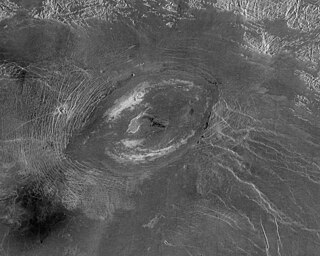
Sacajawea Patera is a large, elongate caldera located in Western Ishtar Terra on the smooth plateau of Lakshmi Planum, on the planet Venus. The image is centred at 64.5 degrees North latitude and 337 degrees East longitude. It is approximately 420 km (260 mi) wide at the base. Sacajawea is a depression approximately 1–2 kilometres (0.62–1.24 mi) deep and 120 by 215 kilometres in diameter; it is elongate in a southwest–northeast direction. The depression is bounded by a zone of circumferential curvilinear structures interpreted to be graben and fault scarps. These structures are spaced 0.5–4 kilometers apart, are 0.6–4.0 kilometers in width and up to 100 km (62 mi) in length. Extending up to approximately 140 km (87 mi) in length from the southeast of the patera is a system of linear structures thought to represent a flanking rift zone along which the lateral injection and eruption of magma may have occurred. A shield edifice 12 km (7.5 mi) in diameter with a prominent central pit lies along the trend of one of these features.
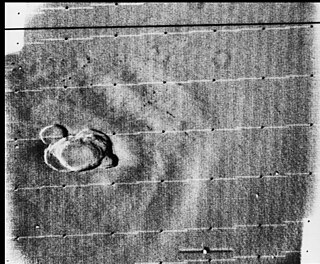
Volcanic activity, or volcanism, has played a significant role in the geologic evolution of Mars. Scientists have known since the Mariner 9 mission in 1972 that volcanic features cover large portions of the Martian surface. These features include extensive lava flows, vast lava plains, and the largest known volcanoes in the Solar System. Martian volcanic features range in age from Noachian to late Amazonian, indicating that the planet has been volcanically active throughout its history, and some speculate it probably still is so today. Both Earth and Mars are large, differentiated planets built from similar chondritic materials. Many of the same magmatic processes that occur on Earth also occurred on Mars, and both planets are similar enough compositionally that the same names can be applied to their igneous rocks and minerals.

The Tharsis quadrangle is one of a series of 30 quadrangle maps of Mars used by the United States Geological Survey (USGS) Astrogeology Research Program. The Tharsis quadrangle is also referred to as MC-9 . The name Tharsis refers to a land mentioned in the Bible. It may be at the location of the old town of Tartessus at the mouth of Guadalquivir.

The Ceraunius Fossae are a set of fractures in the northern Tharsis region of Mars. They lie directly south of the large volcano Alba Mons and consist of numerous parallel faults and tension cracks that deform the ancient highland crust. In places, younger lava flows cover the fractured terrain, dividing it into several large patches or islands. They are found in the Tharsis quadrangle.
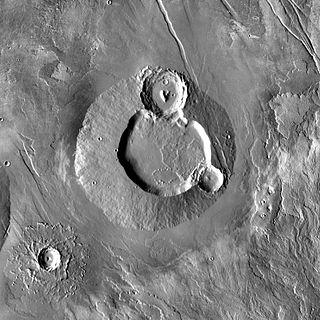
Ulysses Tholus is a Martian volcano. It is located in the Tharsis quadrangle at 2.89° north latitude and 121.55° west longitude. It is 58 km across and is named after a classical albedo feature. Ulysses Tholus is immediately east and slightly north of another volcano, Biblis Tholus. The name of the mountain itself was changed on September 19, 2007. The former terminology, Ulysses Patera, now applies only to the central caldera, whereas formerly it had applied to the whole edifice. Tholus describes a volcanic edifice somewhat smaller than would be implied by mons.

Endeavour is an impact crater located in the Meridiani Planum extraterrestrial plain within the Margaritifer Sinus quadrangle (MC-19) region of the planet Mars. Endeavour is about 22 kilometers (14 mi) in diameter. Using Mars Reconnaissance Orbiter data, phyllosilicate-bearing outcrops have been detected along its rim. These minerals may have formed under wet conditions in a low-acidic environment during the early history of Mars. There are raised rim segments to the north, east, and southwest. The rim has become worn, rounded and degraded, with infilling of plains material in a manner similar to the Victoria crater.

Hesperia Planum is a broad lava plain in the southern highlands of the planet Mars. The plain is notable for its moderate number of impact craters and abundant wrinkle ridges. It is also the location of the ancient volcano Tyrrhena Mons. The Hesperian time period on Mars is named after Hesperia Planum.

Elysium Planitia, located in the Elysium and Aeolis quadrangles, is a broad plain that straddles the equator of Mars, centered at 3.0°N 154.7°E. It lies to the south of the volcanic province of Elysium, the second largest volcanic region on the planet, after Tharsis. Elysium contains the major volcanoes Elysium Mons, Albor Tholus and Hecates Tholus. Another more ancient shield volcano, Apollinaris Mons, is situated just to the south of eastern Elysium Planitia. Within the plains, Cerberus Fossae is the only Mars location with recent volcanic eruptions. Lava flows dated no older than 0.2 million years from the present have been found, and evidence has been found that volcanic activity may have occurred as recently as 53,000 years ago. Such activity could have provided the environment, in terms of energy and chemicals, needed to support life forms.

Eden Patera is a feature located in the Mare Acidalium quadrangle on the planet Mars. In October 2013 the feature gained some attention when it was speculated it may be a supervolcano rather than an impact crater, according to research from the Planetary Science Institute in Tucson, led by Joseph R. Michalski. The research postulated the crater was formed by the volcano's caldera collapsing, rather than from an impact. Some of reasons for suspecting that Eden Patera is a collapsed caldera not an impact crater are its irregular shape, an apparent lack of a raised rim or central peak, and lack of impact ejecta.

Irnini Mons is a volcanic structure on the planet Venus, and is named after the Assyro-Babylonian goddess of cedar-tree mountains. It has a diameter of 475 km (295 mi), a height of 1.75 km (1.09 mi), and is located in Venus' northern hemisphere. More specifically, it is located in the central Eistla Regio region at in the V-20 quadrangle. Sappho Patera, a 225 km (140 mi) diameter wide, caldera-like, depression tops the summit of Irnini Mons. The primary structural features surrounding Irnini Mons are graben, seen as linear depressed sections of rock, radiating from the central magma chamber. Also, concentric, circular ridges and graben outline the Sappho Patera depression at the summit. The volcano is crossed by various rift zones, including the north-south trending Badb Linea rift, the Guor Linea rift extending to the northwest, and the Virtus Linea rift continuing to the southeast.

Patera is an irregular crater, or a complex crater with scalloped edges on a celestial body. Paterae can have any origin, although majority of them were created by volcanism. The term comes from Latin language, where it refers to a shallow bowl used in antique culture.

